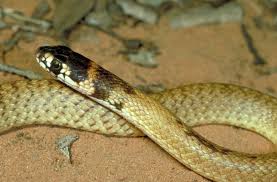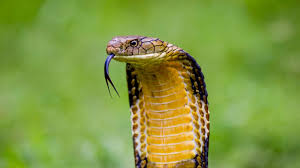General Facts About Snakes
How
Snakes Move
The bodies of snakes have no feet, flippers
or legs to propel them along. They must use the action of their scales and
muscles to scoot their bodies across the ground. The scales on the underside of
their bodies are specialized for this purpose like the tread on a tire.
Different species of snakes use one of the
four manners of movement: concertina, serpentine, sidewinding, and caterpillar.
Where Do Snakes Live?
Snakes are common animals and chances are
that you have seen a snake slithering around at some point in your life. They
can be found on every continent on Earth except Antarctica and can be found in
a variety of habitats. A habitat is a place where an animal naturally lives and
includes the animal’s surroundings and home.
Some snakes live in habitats on land,
including forests, prairies, and deserts. Others live in water environments.
Even though snakes can be found all over the world, most of the snakes live in
warm tropical climates.
Did you know that snakes need to control
their own body temperature? You can find snakes laying in the sun to warm
themselves up and slithering to shady spots to cool themselves down. Snakes
that live in cold places hibernate (sleep) all throughout the winter so that
they survive!

How do snakes sleep?
The snakes have a circadian rhythm, and
this is when they are totally active at a certain period of time. There are
some snakes that are completely diurnal while others are completely nocturnal.
However, others are found in between. Others will be active in the night or in
the day according to the season. This is why it is hard to talk about how long
the snake can sleep. Sometimes the snakes may exhibit sleep-like behaviors such
as staying in one place for some hours, days and sometimes weeks without
moving. However, the snake may exhibit this behavior when in reality it is
foraging. A snake in this position may be waiting for prey, ready to ambush,
envenomate or strike, and it will be fully aware of its surrounding. During
this time, the snake will not sleep but will be completely attentive.
The eyes of the snakes do not have eyelids
and they are covered by clear scales in the wild and in captivity. A motionless
snake may never twitch and all signs that seem to show that an animal is
sleeping like irregular heartbeat and breathing may just be normal to the
snake. Since a snake will not be able to hear loud noises or see bright lights,
it is hard to known when it is sleeping because it won’t react.
It is known that snakes do sleep, but what
is not clear is for how long, how deep it can sleep, if it has a paradoxical
sleep or not, and if it dreams. The sleep pattern is also different for various
species of snakes. The snakes may also yawn but only as a way of gathering
chemical cues or repositioning the musculoskeletal elements, which are not the
same reasons that humans yawn. Sleep is important in the human biology, but the
benefits of sleep in snakes are not well studied and more information is
needed.

What should you do when a
snake approaches you? I heard that one must stand still and the snake will not
attack. Is this true?
When you see a wild snake approaching you,
hold stock still. If you make a movement, it will see you and flee. If you make
no movement, it just might get close enough for you to observe a fascinating
creature in very close proximity. No snake wants to have anything to do with a
human; if it is approaching you, it obviously doesn’t see you.
There is a common but false impression that
snakes are bloodthirsty creatures that want to get people. Nothing could be
farther from the truth. The only reason a snake will bite a person is if it is
attempting to protect itself. Often this will happen if a person takes a snake
by surprise by nearly trodding on it.
If you see a snake moving toward you, a
simple movement will cause the snake to freeze to escape detection (and
subsequent predation as far as it knows), or it will flee for its life.
Snake Protection : Snake
Boots, Gaiters, Chaps and Gloves
Throughout the world, people are living,
working and playing in venomous snake territory every day. Venomous snakes are found in every continent
besides Antarctica and are responsible for 2.5 million envenoming snake bites,
resulting in up to 125,000 deaths each year.
While most snake bites are nonlethal with the help of medical treatment
and antivenom, most are also preventable.
Aside from avoidance, the most effective means of snake bite prevention
is by using snake protective clothing such as snake boots, snake gaiters, snake
chaps, and snake
Unfortunately, the parts of the world with
the most snake bites and deaths are also parts of the world where poverty is
very prevalent and antivenoms are very limited in supply. To make matters worse, the average person
cannot even fathom spending money on snake proof clothing as food and water are
more important.
Here is a list of the different types of
snake protective clothing and the ways in which it prevents bites:
Snake Boots
Perhaps the common method of snake
protection is through the use of snake boots.
Most snake boots that are designed to stand alone in snake bite
prevention are more than twice the height of regular boots. The common length is between 16 and 18
inches, which is beyond the most common striking height of snakes when it comes
to the lower extremities. Most boots
will resist penetration of snake bites without any special fabrics, but many of
the higher end products claim to use puncture proof materials. Even though snake boots are substantially
taller than standard boots, the difference in comfort goes mostly unnoticed
unless the temperatures are hot. Even
when noticed though, the piece of mind that snake boots give a person is worth
any downside they may experience.
Snake Gaiters
A close second in snake bite prevention are
Snake Gaiters. These are basically
gaiters that are designed to stop the penetration of snake fangs. There are many different brands out there and
most of them are effective at heights similar to snake boots at about 16-18
inches. Snake gaiters differ from
manufacture to manufacture with the cheaper examples made out of hard plastics
and PVC and the more expensive ones made out of high quality puncture proof
fabrics. Obviously the more expensive
fabric models are more comfortable, but they will cost a person twice as much. The main consideration when buying snake
gaiters is that they are something you will wear. Most of the less expensive models are far
less comfortable, hotter, and sweatier than the more expensive models. If you buy the cheap pair but don’t wear them
then they won’t do you much good.
Snake Chaps
Designed to protect more than just the
lower half of the leg, snake chaps, also known as snake leggings, typically
attach to a belt or belt loop and run the entire length of the leg clear down
to the boot. Snake chaps are good for
areas that are home to the longer species of venomous snakes such as
Diamondback Rattlesnakes and Cobras, as their reach can easily exceed that of a
person’s knee. Again, like snake
gaiters, there are both expensive and less expensive brands of snake
chaps. One thing that is common among
the lower priced models is that many only offer snake proof protection to the
knee and not above. This is even the
case on some expensive models as well so it is important to find this
information out before you buy.
Protection below the knee is no better that the less restrictive and
less expensive snake gaiters.
Snake Gloves
When most people think of snake bites they
think of stepping on a snake and getting bit.
What many fail to realize is that many snake bites occur to the fingers
and hands of people. This is why snake
gloves are also an important part of snake bite prevention. Most bites to the hands occur when doing such
activities as gardening, picking up brush, or sticking hands in places where
snakes might be hiding. As you probably
already know, snakes blend into their environment very well and unless they
hiss or rattle, most will not ever be seen.